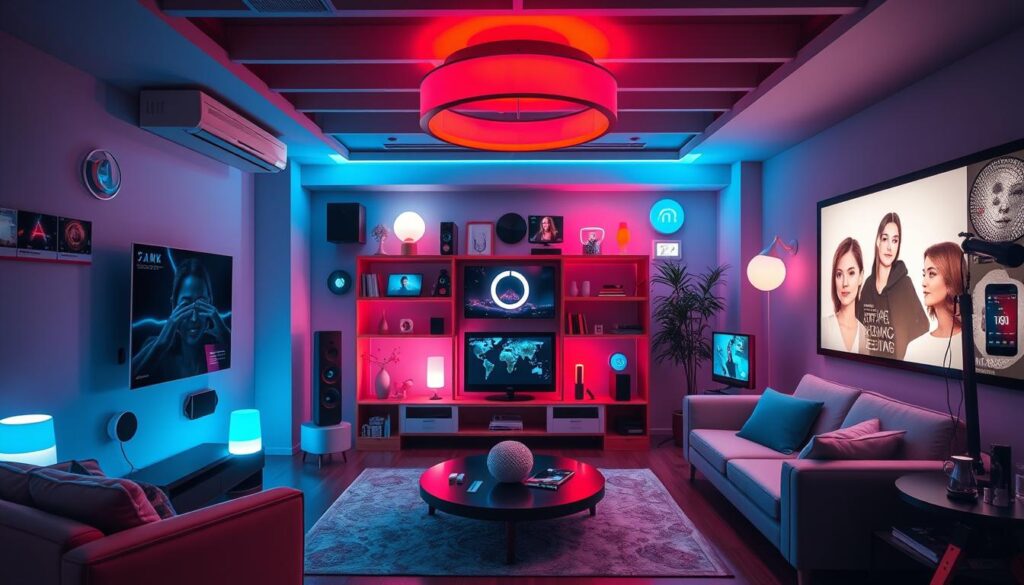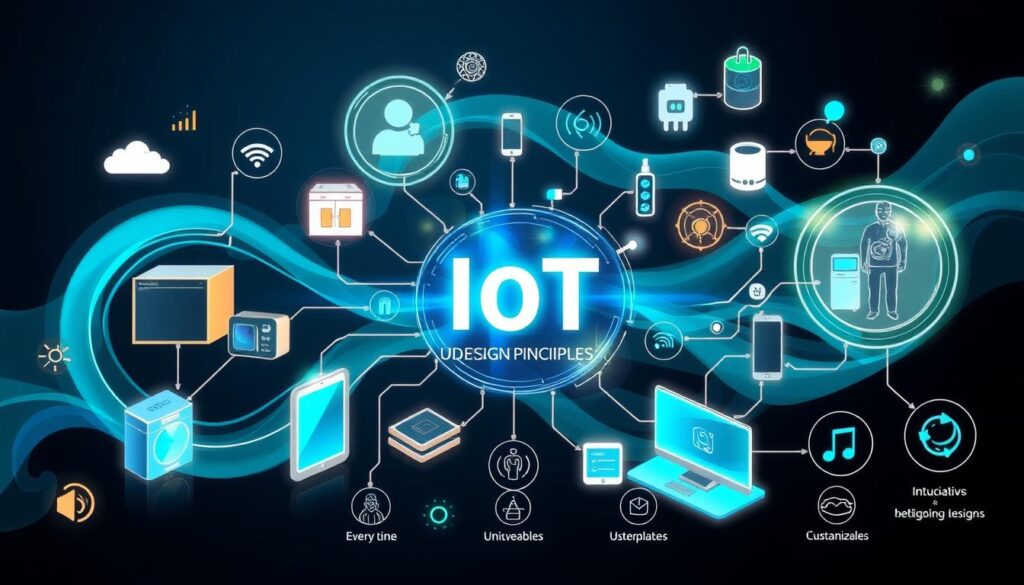The Internet of Things (IoT) is changing how we interact with our surroundings. Designing great user experiences for IoT products is now more important than ever. As the IoT market grows, designers and product teams must focus on user experience. This is key to getting people to use, enjoy, and keep using IoT products.
This guide will show you the 5 main principles for making IoT experiences better. You’ll learn how to make them easy to use, seamless, and tailored to each user. By doing this, you can build trust and keep users coming back for more.
Key Takeaways
- Understand the evolving IoT user experience landscape and the unique challenges it presents
- Discover the 5 essential principles for designing exceptional IoT user experiences
- Learn how to create intuitive and effortless IoT interactions through simplicity
- Explore strategies for seamlessly integrating physical and digital worlds in IoT products
- Understand the importance of personalization in delivering tailored IoT experiences
- Prioritize security and privacy to build user trust and confidence
- Embrace an iterative design approach to continuously improve IoT user experiences
Understanding the IoT User Experience Landscape
The world is getting more connected, thanks to IoT (Internet of Things) devices. These devices, like smart home systems and fitness trackers, are now part of our daily lives. But, the fast growth of IoT brings new challenges in making user experiences smooth.
The Rise of IoT Devices
IoT devices have grown a lot in recent years. The global IoT market is expected to hit over $1.1 trillion by 2026. People are using more connected products, from smart home assistants to AI-powered appliances. This growth makes the IoT landscape complex, posing big IoT user experience challenges for designers.
Challenges in IoT User Experience Design
Designing for connected devices is complex. IoT products mix physical and digital interfaces. Designers must ensure these interactions are smooth and IoT user-friendly. They also need to handle data privacy, security, and make sure devices work well together.
| Key IoT User Experience Challenges | Implications for Designers |
|---|---|
| Fragmented user journeys | Ensuring consistent and intuitive experiences across multiple devices and platforms |
| Complexity of connected ecosystems | Integrating physical and digital interactions to create a cohesive user experience |
| Data privacy and security concerns | Addressing user trust and building confidence in the safety of IoT products |
It’s key to understand IoT device trends and IoT user experience challenges for designing the future. By tackling the complexities of designing for connected devices, designers can make IoT experiences that meet user needs.

5 Keys to Designing User Experience for IoT Products
Creating great user experiences for IoT products needs careful planning. Focus on five key areas to make your IoT products easy to use, tailored to each user, and safe. This builds trust and keeps customers coming back.
- Simplicity: Keep things simple and easy to use. Use clean designs that help users navigate tasks smoothly.
- Seamless Integration: Make the physical and digital worlds work together smoothly. Use context to guess what users need and make interactions easy.
- Personalization: Customize the IoT experience for each user. Give them insights and suggestions based on their habits and preferences.
- Security and Privacy: Make sure your IoT product is safe and respects users’ privacy. This builds trust and confidence.
- Continuous Improvement: Always be open to feedback and ready to improve. Update your IoT product to meet changing user needs.
By following these IoT UX design principles, you can make keys to successful IoT experiences. You’ll deliver the essential elements of IoT product design that users want.

| Principle | Description |
|---|---|
| Simplicity | Minimize complexity and guide users intuitively through tasks. |
| Seamless Integration | Blend physical and digital worlds, leveraging contextual awareness. |
| Personalization | Tailor the experience to individual preferences and usage patterns. |
| Security and Privacy | Implement robust security measures and prioritize user privacy. |
| Continuous Improvement | Embrace an iterative design process, adapting to evolving user needs. |
Simplicity: Keeping It Intuitive and Effortless
In the world of IoT, simplicity is key. Users face a complex landscape of connected devices. To make things easier, we need to simplify IoT interfaces and minimize cognitive load. Good IoT product design makes using these technologies smooth and easy.
Designers can make IoT easier by focusing on clean interfaces. Removing extra features and distractions helps users stay focused. This makes using devices more straightforward and reduces cognitive load.
- Use intuitive gesture controls and natural language interfaces for a better intuitive IoT product design.
- Apply machine learning and AI to guess what users need and offer help, making simplifying IoT interfaces easier.
- Make sure labels are clear, icons are consistent, and navigation is easy to follow for smooth interactions.
By focusing on simplicity and reducing cognitive load, designers can help users get the most out of IoT. This approach boosts user satisfaction and builds trust. It sets the stage for a future where IoT is a seamless part of our lives.
Seamless Integration: Bridging Physical and Digital Worlds
Designing great user experiences for IoT products is all about balance. By integrating physical and digital IoT experiences, you make interactions smooth and easy. This section will look at how to use leveraging contextual data for IoT UX and creating frictionless IoT interactions.
Incorporating Contextual Awareness
IoT devices work best when they know their surroundings. By leveraging contextual data, like location and time, they can offer personalized experiences. This makes users happier and more engaged.
Using sensors and AI helps IoT devices understand the user’s needs. They can then respond in a way that feels natural and meaningful.
Enabling Frictionless Interactions
The goal in IoT design is to make interactions feel natural and easy. This means fewer steps, automated tasks, and a smooth transition between physical and digital. By thinking ahead and simplifying things, you create experiences that are enjoyable and engaging.
Finding the right mix of physical and digital is key for great IoT experiences. By integrating physical and digital IoT experiences, leveraging contextual data for IoT UX, and creating frictionless IoT interactions, you can make the most of IoT technology. And your users will love it.
Personalization: Tailoring Experiences to Individual Needs
In the world of the Internet of Things (IoT), a one-size-fits-all approach won’t work. Designers must understand user preferences, habits, and needs to create engaging personalized IoT experiences. This section will show you how to customizing IoT product interfaces and adaptive IoT UX design to fit into users’ lives.
To succeed in IoT personalization, you need to know your audience. Collect data on their behavior, preferences, and challenges. Then, tailor your product’s features, functionality, and interface to meet their specific needs. This approach boosts user satisfaction and builds a strong bond between the user and your IoT device.
Using machine learning and artificial intelligence for adaptive IoT UX design is a smart strategy. It allows your product to adjust settings, recommendations, or the visual interface based on user habits and preferences. This way, you can anticipate and meet individual needs, making the user experience seamless and enjoyable.
The key to delivering personalized IoT experiences is understanding your users and continually improving your customizing IoT product interfaces. By focusing on personalization, you can unlock your IoT products’ full potential. This creates a lasting, meaningful connection with your customers.
| Key Strategies for Personalized IoT Experiences | Benefits |
|---|---|
| Gather user data and insights Leverage AI and machine learning for adaptive design Continuously refine and iterate on user interfaces | Enhanced user satisfaction and loyalty Deeper connection between users and IoT devices Improved product adoption and retention |
Security and Privacy: Building Trust and Confidence
IoT devices are now a big part of our lives. It’s more important than ever to focus on security and privacy. To gain trust, you must have strong security and protect user privacy.
Implementing Robust Security Measures
Keeping your IoT devices safe from cyber threats is key. Follow these steps to improve your product’s security:
- Regularly update firmware and software to address vulnerabilities
- Use strong encryption protocols to secure data transmission and storage
- Implement multi-factor authentication to prevent unauthorized access
- Continuously monitor for suspicious activities and promptly address any security incidents
Prioritizing User Privacy
Keeping user privacy safe is vital for trust in your IoT products. Make sure to:
- Obtain clear and explicit consent from users for data collection and usage
- Provide transparent privacy policies that explain how user data is handled
- Offer granular control over data sharing and privacy settings
- Implement robust data anonymization and encryption techniques
By tackling these security and privacy issues, you can earn trust in IoT products. This will make your products more reliable and trustworthy. It will also improve the user experience.
Continuous Improvement: Embracing Iterative Design
Creating great IoT user experiences is a never-ending journey. The secret to success is a culture of constant improvement. By using an iterative design approach, companies can keep their IoT products fresh and exciting. They also make sure they meet the changing needs of their customers.
It’s important to have ongoing feedback loops for iterative IoT UX design. Collecting user feedback, analyzing data, and watching market trends helps teams make smart choices. This way, they can improve the IoT experiences as they go. It lets them adjust and fine-tune their products to match what users want and what’s new in tech.
Using continuous feedback loops for IoT products helps companies respond fast to what users need and like. By always adapting IoT experiences based on user data, companies can offer solutions that really speak to their audience. This leads to happier customers, more engagement, and loyalty.
